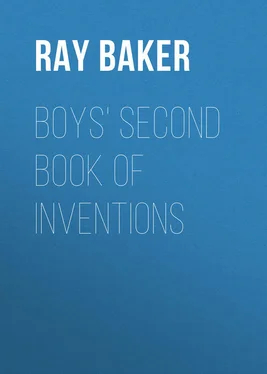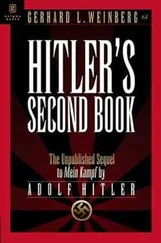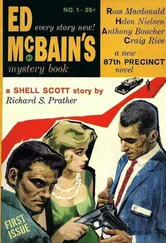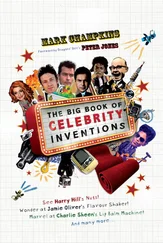Ray Baker - Boys' Second Book of Inventions
Здесь есть возможность читать онлайн «Ray Baker - Boys' Second Book of Inventions» — ознакомительный отрывок электронной книги совершенно бесплатно, а после прочтения отрывка купить полную версию. В некоторых случаях можно слушать аудио, скачать через торрент в формате fb2 и присутствует краткое содержание. Издательство: Иностранный паблик, Жанр: foreign_antique, foreign_prose, foreign_children, на английском языке. Описание произведения, (предисловие) а так же отзывы посетителей доступны на портале библиотеки ЛибКат.
- Название:Boys' Second Book of Inventions
- Автор:
- Издательство:Иностранный паблик
- Жанр:
- Год:неизвестен
- ISBN:нет данных
- Рейтинг книги:4 / 5. Голосов: 1
-
Избранное:Добавить в избранное
- Отзывы:
-
Ваша оценка:
- 80
- 1
- 2
- 3
- 4
- 5
Boys' Second Book of Inventions: краткое содержание, описание и аннотация
Предлагаем к чтению аннотацию, описание, краткое содержание или предисловие (зависит от того, что написал сам автор книги «Boys' Second Book of Inventions»). Если вы не нашли необходимую информацию о книге — напишите в комментариях, мы постараемся отыскать её.
Boys' Second Book of Inventions — читать онлайн ознакомительный отрывок
Ниже представлен текст книги, разбитый по страницам. Система сохранения места последней прочитанной страницы, позволяет с удобством читать онлайн бесплатно книгу «Boys' Second Book of Inventions», без необходимости каждый раз заново искать на чём Вы остановились. Поставьте закладку, и сможете в любой момент перейти на страницу, на которой закончили чтение.
Интервал:
Закладка:
So much for the wonders of radium. We seem, indeed, to be on the border-land of still more wonderful discoveries. Perhaps these radium investigations will lead to some explanation of that great question in science, "What is electricity?" – and that, who can say, may solve that profounder problem, "What is life?"
At present there are two theories as to the source of energy in radium, thus stated by Professor Curie:
"Where is the source of this energy? Both Madame Curie and myself are unable to go beyond hypotheses; one of these consists in supposing the atoms of radium evolving and transforming into another simple body, and, despite the extreme slowness of that transformation, which cannot be located during a year, the amount of energy involved in that transformation is tremendous.
"The second hypothesis consists in the supposition that radium is capable of capturing and utilising some radiations of unknown nature which cross space without our knowledge."
CHAPTER II
FLYING MACHINES 1 1 In the first "Boys' Book of Inventions," the author devoted a chapter entitled "Through the Air" to the interesting work of the inventors of flying machines who have experimented with aëroplanes; that is, soaring machines modelled after the wings of a bird. The work of Professor S. P. Langley with his marvellous Aërodrome, and that of Hiram Maxim and of Otto Lilienthal, were given especial consideration. In the present chapter attention is directed to an entirely different class of flying machines – the steerable balloons.
Among the inventors engaged in building flying machines the most famous, perhaps, is M. Santos-Dumont, whose thrilling adventures and noteworthy successes have given him world-wide fame. He was the first, indeed, to build a balloon that was really steerable with any degree of certainty, winning a prize of $20,000 for driving his great air-ship over a certain specified course in Paris and bringing it back to the starting-point within a specified time. Another experimenter who has had some degree of success is the German, Count Zeppelin, who guided a huge air-ship over Lake Geneva, Switzerland, in 1901.
Carl E. Myers, an American, an expert balloonist, has also built balloons of small size which he has been able to steer. And mention must also be made of M. Severo, the Frenchman, whose ship, Pax, exploded in the air on its first trip, dropping the inventor and his assistant hundreds of feet downward to their death on the pavements of Paris.
It will be most interesting and instructive to consider especially the work of Santos-Dumont, for he has been not only the most successful in making actual flights of any of the inventors who have taken up this great problem of air navigation, but his adventures have been most romantic and thrilling. In five years' time he has built and operated no fewer than ten great air-ships which he has sailed in various parts of Europe and in America. He has even crowned his experiences with more than one shipwreck in the air, an adventure by the side of which an ordinary sea-wreck is tame indeed, and he has escaped with his life as a result not only of good fortune but of real daring and presence of mind in the face of danger.
For an inventor, M. Santos-Dumont is a rather extraordinary character. The typical inventor – at least so we think – is poor, starts poor at least, and has a struggle to rise. M. Santos-Dumont has always had plenty of means. The inventor is always first a dreamer, we think. M. Santos-Dumont is first a thoroughly practical man, an engineer with a good knowledge of science, to which he adds the imagination of the inventor and the keen love and daring of the sportsman and adventurer, without which his experiments could never have been carried through.
It would seem, indeed, that nature had especially equipped M. Santos-Dumont for his work in aërial navigation. Supposing an inventor, having all the mental equipment of Santos-Dumont, the ideas, the energy, the means – supposing such a man had weighed two hundred pounds! He would have had to build a very large ship to carry his own weight, and all his problems would have been more complex, more difficult. Nature made Santos-Dumont a very small, slim, slight man, weighing hardly more than one hundred pounds, but very active and muscular. The first time I ever saw him, in Crystal Palace, London, where he was setting up one of his air-ships in a huge gallery, I thought him at first glance to be some boy, a possible spectator, who was interested in flying machines. His face, bare and shaven, looked youthful; he wore a narrow-brimmed straw hat and was dressed in the height of fashion. One would not have guessed him to be the inventor. A moment later he had his coat off and was showing his men how to put up the great fan-like rudder of the ship which loomed above us like some enormous Rugby football, and then one saw the power that was in him. Brazilian by nationality, he has a dark face, large dark eyes, an alertness of step and an energetic way of talking. His boyhood was spent on his father's extensive coffee plantation in Brazil; his later years mostly in Paris, though he has been a frequent visitor to England and America. He speaks Spanish, French, and English with equal fluency. Indeed, hearing his English one would say that he must certainly have had his training in an English-speaking country, though no one would mistake him in appearance for either English or American, for he is very much a Latin in face and form. One finds him most unpretentious, modest, speaking freely of his inventions, and yet never taking to himself any undue credit.
Santos-Dumont is still a very young man to have accomplished so much. He was born in Brazil, July 20, 1873. From his earliest boyhood he was interested in kites and dreamed of being able to fly. He says:
"I cannot say at what age I made my first kites; but I remember how my comrades used to tease me at our game of 'Pigeon flies'! All the children gather round a table, and the leader calls out: 'Pigeon flies! Hen flies! Crow flies! Bee flies!' and so on; and at each call we were supposed to raise our fingers. Sometimes, however, he would call out: 'Dog flies! Fox flies!' or some other like impossibility, to catch us. If any one should raise a finger, he was made to pay a forfeit. Now my playmates never failed to wink and smile mockingly at me when one of them called 'Man flies!' For at the word I would always lift my finger very high, as a sign of absolute conviction; and I refused with energy to pay the forfeit. The more they laughed at me, the happier I was."
Of course he read Jules Verne's stories and was carried away in imagination in that author's wonderful balloons and flying machines. He also devoured the history of aërial navigation which he found in the works of Camille Flammarion and Wilfrid de Fonvielle. He says, further:
"At an early age I was taught the principles of mechanics by my father, an engineer of the École Centrale des Arts et Manufactures of Paris. From childhood I had a passion for making calculations and inventing; and from my tenth year I was accustomed to handle the powerful and heavy machines of our factories, and drive the compound locomotives on our plantation railroads. I was constantly taken up with the desire to lighten their parts; and I dreamed of air-ships and flying machines. The fact that up to the end of the nineteenth century those who occupied themselves with aërial navigation passed for crazy, rather pleased than offended me. It is incredible and yet true that in the kingdom of the wise, to which all of us flatter ourselves we belong, it is always the fools who finish by being in the right. I had read that Montgolfière was thought a fool until the day when he stopped his insulters' mouths by launching the first spherical balloon into the heavens."
Читать дальшеИнтервал:
Закладка:
Похожие книги на «Boys' Second Book of Inventions»
Представляем Вашему вниманию похожие книги на «Boys' Second Book of Inventions» списком для выбора. Мы отобрали схожую по названию и смыслу литературу в надежде предоставить читателям больше вариантов отыскать новые, интересные, ещё непрочитанные произведения.
Обсуждение, отзывы о книге «Boys' Second Book of Inventions» и просто собственные мнения читателей. Оставьте ваши комментарии, напишите, что Вы думаете о произведении, его смысле или главных героях. Укажите что конкретно понравилось, а что нет, и почему Вы так считаете.












